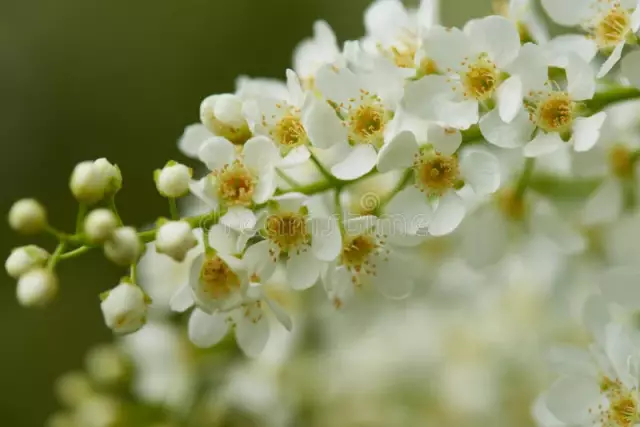- Author Rachel Wainwright [email protected].
- Public 2023-12-15 07:39.
- Last modified 2025-11-02 20:14.
Felt Cherry
The type of cherry, which is small shrubs or trees up to 3 m high and nowadays referred to the genus Plum, is called “Felt cherry”, or scientifically “Prunus tomentosa Thunb”. This plant is completely covered with small chased dark green leaves with soft pubescence, which looks like felt, which explains its name.

Felt cherry is grown as a highly decorative and fruiting plant with juicy non-acidic berries of an oval or round shape. Cherry fruits hang on short stalks, adhering tightly to one another, just like sea buckthorn fruits. The flowering time of the plant falls from the end of April to the beginning of May, the ripening of the fruits - from the end of June to the beginning of July, depending on weather conditions and the growing region.
The homeland of the felt cherry is Mongolia, China and Korea, where it grows wild, in Europe and North America it became widespread only in the middle of the 20th century.
Felt cherry - beneficial properties and composition
Felt cherry berries contain pectins, 16-32 mg of vitamin C, 8-10% of sugars (glucose and fructose), 1% of malic and citric acid, and tannins. 100 g of berry pulp contains 0.6% anthocyanins, 0.29% catechins and 0.17% flavonols, as well as bioactive polyphenols. Thanks to these substances, the felt cherry is an effective capillary-strengthening agent.
Despite all the beneficial properties, felt cherries are practically not used in traditional medical practice, however, many doctors recommend eating the fruits to increase the regular activity of the intestines, improve the digestion of fats and proteins, and increase appetite.
The kernels are rich in fatty oil (from 17 to 35%), which contains linoleic acid, which has an anti-atherosclerotic effect. It is better not to use them without a doctor's recommendation, because they contain the glycoside amygdalin, which, breaking down in the intestine, forms hydrocyanic acid.
Felt cherries are rich in vitamins C, B, PP and P, and they contain more iron than apples. It is useful for anemia, helps to reduce the growth of atherosclerotic plaques, lowers blood pressure, and prevents the development of stroke and heart attack.
The energy value of 100 g of felt cherry is 52 kcal, the protein content is 0.8 g, fat - 0.2 g, carbohydrates - 10.6 g.
Felt cherry - recipes
The sweet berries of felt cherries are a dietary product; they can be consumed in the presence of kidney and liver stones, gastritis and ulcers of the intestines and stomach, as well as those who wish to lose weight.
According to reviews, felt cherries are the most useful and tasty fresh, but in cooking it is customary to process or dry them, they make juices, preserves, compotes, jams, syrup and fruit drink from it.
The process of preserving the berries of this cherry variety is similar to the recipe for blanks from ordinary garden cherries. If sugar is not added to it, but fructose is used as a sweetener, such a delicacy can be used even with mild diabetes.
Felt cherry marmalade is very popular, the recipe for which has been passed down from generation to generation in Korea, from where it spread throughout the world. Cherry fruits (600 g) are thoroughly washed under cold water, peeled from the stalks and seeds, put in a large saucepan, filled with 3 glasses of water and boiled until boiled.
Then the berries are passed through a sieve, the resulting cherry mass is again put on low heat, 150 g of sugar are added to it and boiled until it begins to thicken. Then 2 tbsp are added to the cherry mass. l. honey and 5 tbsp. l. starch, diluted in the same amount of water, the liquid is constantly stirred and boiled until its consistency begins to resemble a thick jelly. The finished mass is poured into molds and cooled for 3 hours, after which the marmalade is cut and ready for use.
Many housewives prefer to peel the fruits of felt cherries and cover them with sugar, then put them in jars and close them with plastic lids, getting a kind of jam.
Felt cherry jam is cooked using the same technology as any other jam, however, you can put much less sugar in it, because sourness is unusual for the berries of this cherry variety.
According to reviews, felt cherry is an excellent raw material for making compotes for the winter. The berries are washed out and laid out in sterile jars, doused with boiling water, poured to the very neck with boiling sugar syrup and closed with sterile lids. One liter of syrup should have 400 g of sugar; the finished compote can be stored for no more than 8 months in a dark, cool place.
Felt cherry is a fruiting plant that spread throughout the world from Asia and is popular for its delicious and sweet berries. The beneficial properties of this cherry variety allow it to be used in the treatment of various diseases, and the low calorie content makes it an ideal product for dieting.
YouTube video related to the article:
Found a mistake in the text? Select it and press Ctrl + Enter.






